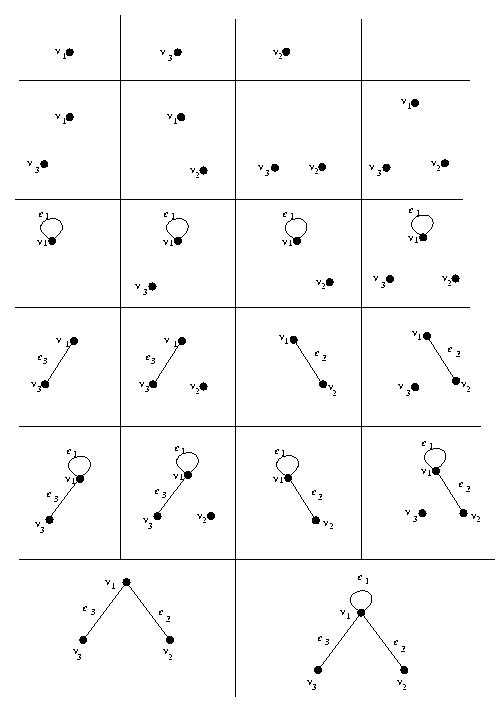
5. A subgraph of a graph G is a graph which contains some (or all) of the vertices of G and some (or all) of the edges of G. Isolated vertices are allowed.
The 21 subgraphs of this graph are given first pictorially, and then listed as vertex and edge sets.

We now list the vertex set together with the edge set of all the subgraphs (graphs are listed in the order they appear in the diagram above).
V(H) = {v1} and E(H) = Æ,
V(H) = {v3} and E(H) = Æ,
V(H) = {v2} and E(H) = Æ,
V(H) = {v1,v3} and E(H) = Æ,
V(H) = {v1,v2} and E(H) = Æ,
V(H) = {v3,v2} and E(H) = Æ,
V(H) = {v1,v2,v3} and E(H) = Æ,
V(H) = {v1} and E(H) = {e1},
V(H) = {v1,v3} and E(H) = {e1},
V(H) = {v1,v2} and E(H) = {e1},
V(H) = {v1,v2,v3} and E(H) = {e1},
V(H) = {v1,v3} and E(H) = {e3},
V(H) = {v1,v2,v3} and E(H) = {e3},
V(H) = {v1,v2} and E(H) = {e2},
V(H) = {v1,v2,v3} and E(H) = {e2},
V(H) = {v1,v3} and E(H) = {e1,e3},
V(H) = {v1,v2,v3} and E(H) = {e1,e3},
V(H) = {v1,v2} and E(H) = {e1,e2},
V(H) = {v1,v2,v3} and E(H) = {e1,e2},
V(H) = {v1,v2,v3} and E(H) = {e2,e3},
V(H) = {v1,v2,v3} and E(H) = {e1,e2,e3},